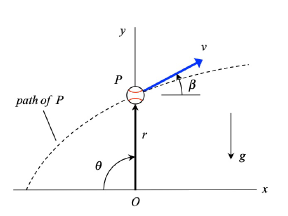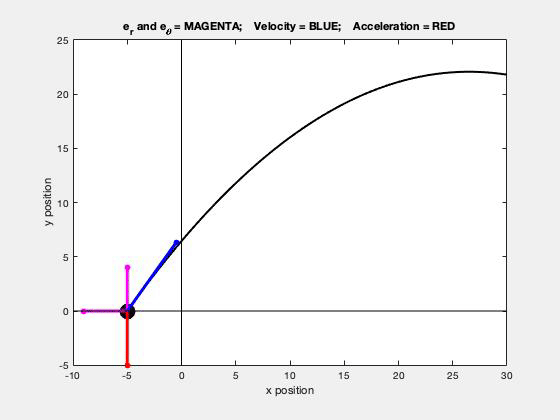| Problem statement Solution video |
DISCUSSION THREAD

We encourage you to interact with your colleagues here in conversations about this homework problem.
DISCUSSION and HINTS

The problem is posed in terms of a mixture of path and polar descriptions. We are asked to find path variable descriptions for rate of change of speed and radius of curvature.
The two path unit vectors of e_r and e_theta are shown above in magenta in the above animated GIF. The velocity (in blue) is tangent to the path, as expected. The acceleration (in red) has both tangential and normal components: the normal component always points inward on the path, and the size and sign of the tangential component are directly tied to the rate of change of speed of P, also as expected.
In terms of problem solving, the following steps are recommended:
- Show both sets of unit vectors in your sketch: e_t, e_n, e_r, e_theta.
- Using the sketches, determine numerical values for r_dot, theta_dot, r_dotdot and theta_dotdot, based on the known velocity v and acceleration a vectors.
- Take the dot product of a with e_t to find the rate of change of speed, v_dot.
- Use the magnitude of the acceleration vector to solve for the radius of curvature, rho.
Please note that "r" is radial distance between O and P, and it is NOT the radius of curvature for the path.
For this problem I wrote my kinematic equations in terms of polar and path coordinates. From setting the equivalent equations for velocity I was able to solve for theta_dot, r_dot, and r_double_dot. I still need to solve for theta_double_dot, but I am confused on how to do this. I know I have to use the equivalent acceleration equations, and I think I have to tie gravity into it somehow but for the time being I am stuck. Can anyone point me in the right direction?
Note that you are GIVEN the velocity and acceleration of the ball in terms of Cartesian components: v = v*(cos(beta)*i + sin(beta)*j) and a = -g*j.
There are two parts to this problem: In the first part (Part (b) one you are essentially asked to find the polar coordinates of velocity and acceleration. For this, you will use j = e_r and i = e_theta.
In the second part (Part (d)), you need can use the results from today's class of v_dot = a•e_t (where "•" is the dot product, and the acceleration magnitude equation to find rho.
In addition to what CMK said, I'd double-check your velocity equations, since I don't know of a velocity equation that involves r_double_dot, which is involved in polar acceleration. I find it helpful to count the derivatives (dots) in each term of my polar velocity and acceleration equations. Since velocity is a first-order derivative with respect to time, each term should only have one dot. Since acceleration is a second-order derivative with respect to time, each term should have a total of two dots (whether that's a double dot or product of two single dots). Hope that helps!
Gravity is the only source for acceleration on this projectile. It points in a very specific direction. You can set up an acceleration vector which uses just gravity in terms of e_r and e_theta. Once you have that, you can set that equal to the standard vector for acceleration in terms of the same two unit vectors and solve for theta_double_dot.
You're on the right track with thinking about gravity. Since the problem says to neglect air resistance, the only force acting on the ball is gravity, which we are told acts straight down; ergo, the acceleration is given by -g in the j direction. You can use this acceleration vector to get an equation involving theta_double_dot. I'm curious as to how you were able to solve for r_double_dot without an acceleration vector.
Is it safe to assume that g = 32.2 ft/s^2 (3 significant figures, as the final answers should be reported)?
I would assume so since all the other variables have numbers and are given in terms of ft.
assume gravity as -32.17(unit vector j)ft/s^2. And this value will equivalent to (r(double dot) - r(theta dot)^2)(unit vector j). This information will be helpful to solve the part b of the problem
assume gravity as -32.17(unit vector j)ft/s^2. And this value will equivalent to (r(double dot) - r(theta dot)^2)(unit vector j). This information will be helpful to solve the part b of the problem
Do we have to fine e_theta at some point to fine the variables in part b? I assume it's just 1i though, but I am not completely sure.
I guess it make sense cause e_theta points only towards the i direction. The way I did it is using the angle 90 given, to get both the value for e_theta and e_r ,though I'm not sure if that's the correct way to approach it.
How do I find r dot dot and theta dot dot. I was going to use an equation with acceleration, but I also cannot find the acceleration. Can someone direct me to the next steps?
To calculate r dot dot and theta dot dot take into consideration what the acceleration is in terms of e theta and e r. As mentioned from CMK e theta =i and e r=j and you should be able to solve for r dot dot and theta dot dot.
The way I did it is by describing the gravity acceleration as (-g) in the j direction with g being 32.2 ft/s^2. Then compare it to the polar coordinate which you have change to cartesian component. I hope that helps.
I just want to make sure that I am doing part c right. Is it true that we should be writing e_t = ____phi*e_theta+______phi*e_r? I want to make sure they are in terms of phi since theta is the right angle in this problem.
sorry correction, I mean beta in this problem, not phi
It will be beneficial to draw out the unit vectors for part c) because it will help you make the equations easier to understand. It can be very easy to confuse yourself if you haven't drawn the vectors.
What would the units for r double dot be?
I believe the units would be ft/s^2 since r is ft. r_dot and r_double_dot are now function of time, I may explained it wrong though.
When solving for theda dot, are the units in degrees/s or rad/s? Also, when using theda dot to solve for r and theda double dot, do you use the value of theda dot in degrees/s or rad/s?